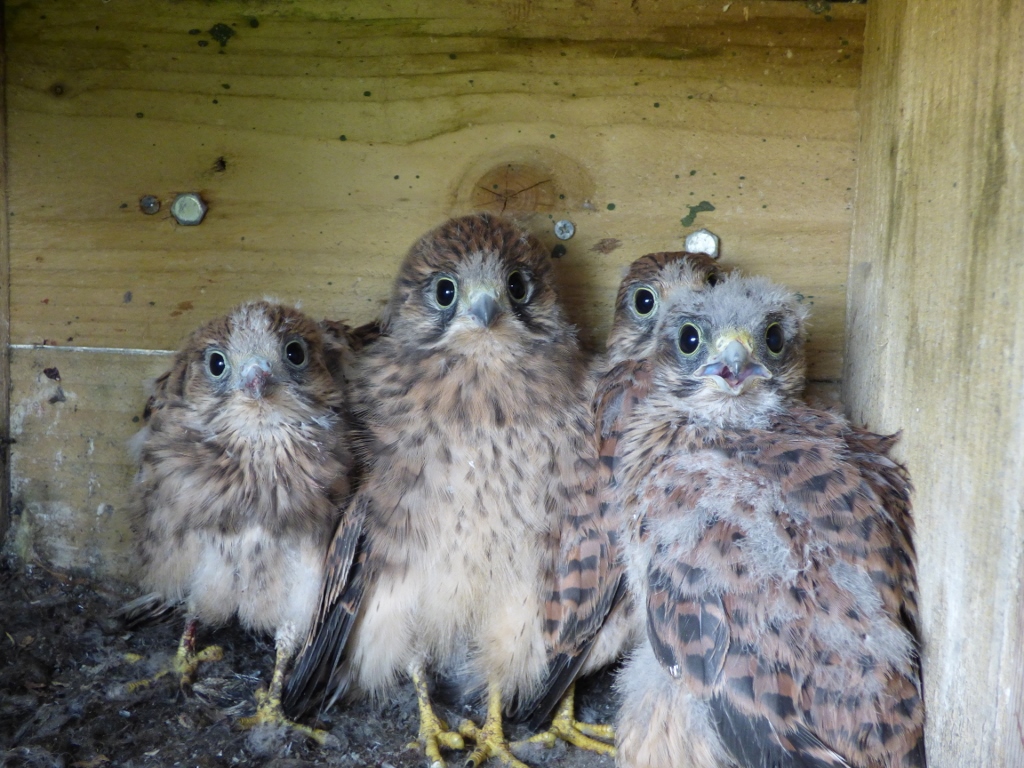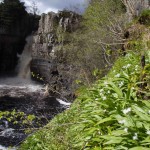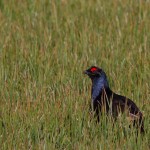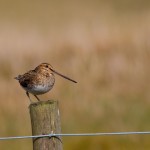Photo taken by Yvonne Hofer of a spotted flycatcher on Baslow Edge September 11th.
Category Archives: Sightings
Bakewell Bird Study Group visit to Macclesfield Forest – March 2019
Saturday 23 March 2019, 09.15 to 13.30
Summary
Macclesfield Forest is a popular area for families and dog-walkers. It also provides good birdwatching opportunities, with a variety of habitats. Although there is no public access to much of the forest interior, there are circular walking routes of varying length on well-maintained paths and tracks. Very little road walking is necessary with footpaths often separated from road traffic by a stone wall.
We gathered in the layby alongside Trentabank Reservoir, from where we had good views of the heronry and 3 Cormorant nests. The weather was good – bright and sunny if a little cool at first. During the course of our visit we saw all six resident crow family members, including a Jay in the woodland and a Raven soaring above us. Both times we passed the Visitor Centre we saw a treecreeper searching for food in the stone wall on the far side of the road.
We completed a circuit of the Ridgegate reservoir, starting through woodland to the south where we heard more birds than we saw. There were 5 female Goosander just out of the water on the stone bank of the dam at the western end of the reservoir.
Returning to our cars, we drove to the car park at the eastern end of the Forest. From here we walked up towards the top of the forest on the south side. It was from here that we saw the Raven and several Curlew.
Thank you to all who came and made this such an enjoyable trip.
Members participating: 14
Bird list (43 species seen and/or heard)
| Great Crested Grebe | Woodpigeon | Blue Tit |
| Little Grebe | Tawny Owl | Great Tit |
| Cormorant | Great Spotted Woodpecker | Nuthatch |
| Grey Heron | Grey Wagtail | Treecreeper |
| Canada Goose | Pied Wagtail | Jay |
| Mandarin Duck | Wren | Magpie |
| Mallard | Dunnock | Jackdaw |
| Tufted Duck | Robin | Rook |
| Goosander | Blackbird | Carrion Crow |
| Sparrow Hawk | Song Thrush | Raven |
| Buzzard | Mistle Thrush | Chaffinch |
| Pheasant | Chiffchaff | Greenfinch |
| Coot | Willow Tit | Goldfinch |
| Curlew | Coal Tit | Siskin |
| Stock Dove |
Carr Vale trip 23rd September 2017
The Bakewell bird study group magic held as usual with the weather with no rain during the trip. The lighting was not best for identification but persistence paid off and we identified a total of 44 species.
This outing was a car share trip and although attendance wasn’t high it turned out to be a very pleasurable morning with plenty of activity in the trees and bushes on route. It was heard said “If only they would stand still for a minute I might be able identify them!”

The varied habitats in the Carr vale reserve make for a wide variety of birds as it is a mixture of open water, marsh, wet and dry grassland, scrub and trees. It was generally felt however that there should have been more waders down on the lake at this time of the year so a little mystery there.
All in all a great trip. Many thanks to Dorothy for organising the trip and to Stuart for passing on his special skills at identification.
The bird list is as follows:-
Great Crested Grebe, Cormorant, Grey Heron, Mute Swan, Greylag, Canada Goose, Wigeon, Gadwall, Mallard, Shoveler, Tufted Duck, Buzzard, Pheasant, Moorhen, Coot, Lapwing, B.H. Gull, L.B.B.Gull, Herring Gull, Stock Dove, Woodpigeon, Collared Dove, Swallow, Meadow Pipit, Pied Wagtail, Wren, Dunnock, Robin, Blackbird, Chiffchaff, Goldcrest, Long-tailed Tit, Blue Tit, Great Tit, Jay, Magpie, Jackdaw, Carrion crow, Starling, Chaffinch, Greenfinch, Goldfinch, Linnet, Bullfinch. Total 44 Species
Kestrel Chicks
Swift Boxes Update
Last month we posted about our new nest boxes for Swifts in the Bakewell Church Tower.
Swifts returned to Bakewell dead on schedule, May 9th, and we almost managed to get our swift boxes ready in time, just a couple of days late. Mike was recovering from his holiday in Germany so this time it was the aforesaid John Boyle, myself and my friend Jack from Sheffield who climbed the stairs and ladder into the belfry. Angela was in Cyprus sunning herself so – no coffee.
While John finished converting the circular holes in the shutters into slots of the designated width (22mm) Jack and I assembled the electrical equipment which makes the swift noises. This consists of a 12v amplifier of the type used on motor cycles, a 240v/12v power adaptor and a pair of speakers or “tweeters”. The amplifier is fitted with an SD card slot, the type you put in your camera, whereas our swift calls had been recorded onto a CD given to us at Tanya Hoare’s swift talk by Andrew and Barbara Wager of Thorpe and I’m very grateful for their help. I cajoled a friend who has a computer with both a disc drive and an SD card slot to transfer the swift calls onto the card then I set it all up in my living room beforehand – and it worked! And all for under £50.
We sited the amplifier adjacent to one of the boxes on the N window and fixed one of the speakers inside (photo). We threaded the speaker cable through the bottom of the box and secured them to the terminals at the back of the amp. Needless to say this is a rather simplified account of what actually happened, in actuality more time was spent discussing methodology, looking for lost screws and avoiding accidents. Then there were the ear piercing bongs every quarter of an hour although it seemed like every 5 minutes: time definitely goes faster in a bell tower (cf Einstein). The second speaker was fitted inside another box on the NW window. All that was needed now was to set the times on the plug socket timer when the calls would play, we chose 7 to 8am and 8 to 9pm.
As we descended into the sunlight swifts were circling the bell tower and we dared to think that they might use the boxes this year….So if you are in Bakewell on a summer evening stroll up to the church and listen to the swifts.
Brian Shaw May 2016
Swift Nest Boxes – April 2016
On April 21st five intrepid climbers scaled the fifty-seven steps up to the ringing chamber of All Saints’ Bakewell church, carrying twelve boxes which Brian Shaw and Mike Nelms had made, to entice our visiting swifts to set up home.

John Boyle, bell-ringer and winder of the church clock, led the way for Brian and Mike to scale a ladder, go through a trap door and emerge into the bell chamber. They spent the next two hours erecting the boxes. The photo shows four in place, with the back slid open to show the entrance hole to the outside world.
Pauline Boyle, the Tower Captain, welcomed us and made sure we knew the safety procedures for working in the tower, and I? I provided the coffee!
The recording of the swifts calls is now being assembled. This will be fitted soon and will play for an hour, morning and evening, from May to July. Young swifts will cruise round to suss out suitable desirable residences for the future, so the boxes may not be used for two or three years.
I am so pleased that the Bird Study Group has adopted this as a project and thank Brian and Mike for giving their time and energy to make it happen. And we thank the church for welcoming their feathered friends. Let’s just hope the swifts aren’t too choosy!
Angela Bird. April 2016.
Please see our update on the swift boxes from May 2016
Wyver Lane Belper – 12th September 2015
The first outdoor meeting of the year began at The Riverside Gardens Belper. Located within the Derwent Valley Mills World Heritage Site and adjacent to Strutts North Mill it proved a worthwhile place to start.
The bird life was very quiet at first but the list of birds began spectacularly when a pair of peregrine falcons came soaring towards the pigeons perching on the mill. They were in no hurry to move, perhaps the pigeons realised that despite the grating scraa coming from the female the peregrines were not hungry.
After this exciting start we walked through the gardens and back along the promenade enjoying the beautiful flower beds and hanging baskets. A grey wagtail was enjoying the pond and black headed gulls the riverside.
We moved on over the river and down Wyver Lane enjoying the riverside gardens belonging to the local houses. We were fortunate to catch a glimpse of a kingfisher cutting across a garden from a pond to the river. As Wyver Lane changed from from housing into fields all seemed very quiet but Stuart was able to pinpoint several smaller birds.
We eventually reached the premier wetland reserve of the DWT. From the hide we were able to watch buzzards and note the very white front of a juvenile which has hints of an osprey. We carried on to the end of the lane where we were treated to a family of jays and a raven flying overhead.
We retraced our steps ending our visit in style. Whilst watching the feeders in one of the gardens a sparrow hawk lived up to its name as it came in swiftly to attack the the house sparrows. Coming from behind us it gave a spectacular acrobatic display.
Bird list – wood pigeon, feral pigeon, magpie, blackbird, mallard, house martin, swallow, peregrine falcons, moorhen, robin, grey wagtail, great tit, tufted duck, black headed gull, muscovy duck, mute swan, little grebe, chiffchaff, canada goose, carrion crow, greenfinch, jay, kingfisher, buzzard, heron, cormorant, teal, chaffinch, jackdaw, dunnock, greater spotted woodpecker, goldcrest, siskin, raven, pheasant, nuthatch, blue tit, goldfinch, wren, greylag, house sparrow, sparrow hawk.
by Veronica Wheeldon
ALKBOROUGH TRIP – 17TH OCTOBER 2015
The Evans magic worked again. The weather forecast said heavy cloud and cold winds off the North Sea and hinted at something even worse. The reality was broken cloud, bursts of sunshine and a gentle breeze. So eighteen members were able to explore Alkborough Flats without streaming eyes and without clinging on to wind-rocked telescopes.
The Flats are well named. The Lincolnshire Wolds end abruptly with a few houses and a church and then, where the Trent meets the Humber, the land tumbles down to an expanse of reed and marsh and lagoons. The paths through the reeds are raised and well maintained; the hides solid and cleverly sited.
Most of the birds listed were seen, but some, like the Cettis Warbler, only heard. Just a few years ago the news of a Cettis this far north would have had the twitchers flocking. Now we put it on the list along with the Little Egret and move on.
Also more vocal than visible was the Water Rail, doing its imitation of an outraged pig.
Three Marsh Harriers seemed to be sharing a narrow strip of territory, rising and falling and getting in each other’s way. Once it appeared that two of them had had a mid-air collision but perhaps it was just something that Marsh Harriers do. But at least they were easy to watch.
Not like Bearded Tits. A bright flash as they flit from one reed to an identical one and they have gone before you can raise your binoculars.
But, for me at least, the highlight of the day was the view from one hide of ducks and waders spread over the water and mud banks of a lagoon like an illustration of a ‘Teach Yourself Bird Recognition’.
How many? Difficult to say. A single Heron, a few Curlew and Ruff, dozens of other species of duck and wader as well as a hundred-plus Lapwing and even more Golden Plover. But other people may have counted more. And the surprising thing, to me at least, was how colourful they were. No winter drab yet. The Golden Plover still had golden flecks and the Lapwing still had bright heads and a greenish sheen.
Every now and again, for no apparent reason, the Golden Plover would take off, fly around in a tight flock then land again while everything else ignores them and gets on with dabbling and probing.
Just before leaving the marshes, as seventeen members were peering down a drain in search of an elusive Water Rail, the lucky eighteenth was the sole witness of the classic panic of the ducks and the waders as a Peregrine passed overhead.
And finally, by some thoughtful management, the mini-bus was waiting at the foot of the hill and sixteen*grateful members were saved a long wearisome climb. (*Two of our number came by car).
Thanks for a smooth ride to the driver who happened to be a birdwatcher and brought his own telescope (perhaps we should have charged him) and to Stuart Slack for instant recognitions, both seen and heard, (sometimes of things that only he has seen or heard) and most of all to Dorothy for seamless arrangements.
Species seen
Juvenile gannet at Middleton Moor on 1 October
Teesdale 2015
Photographs taken by David Frost on a club visit to Teesdale on 17-19th May 2015.
Click on an image to see a larger version.
- by David Frost
- by David Frost
- by David Frost
- by David Frost
- by David Frost
- by David Frost
- by David Frost










